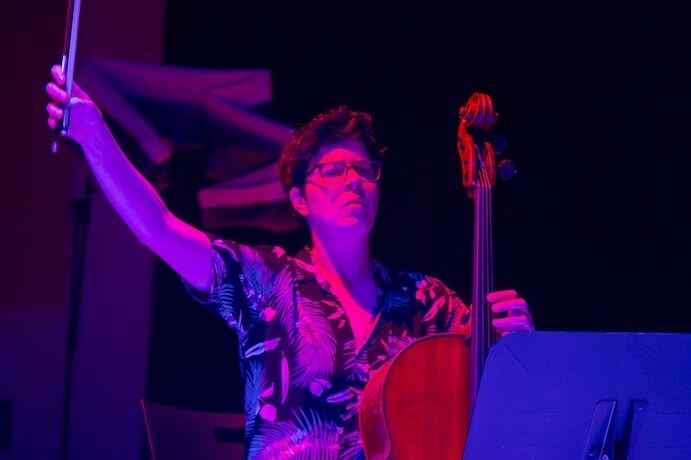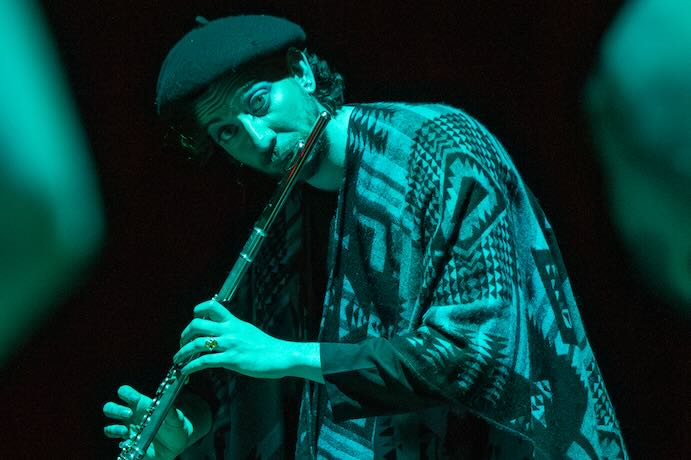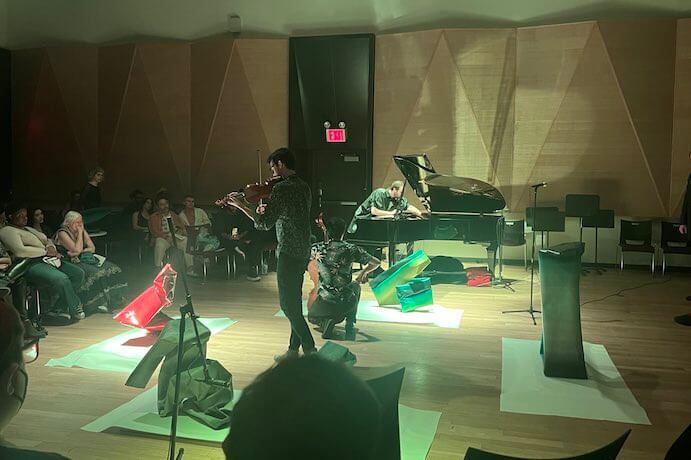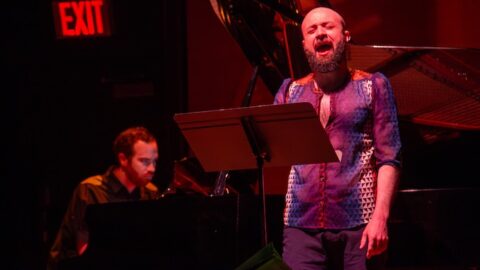Upon taking my program and entering the large room at The Lesbian, Gay, Bisexual & Transgender Community Center in Manhattan, I was reminded how much the setup of a venue informs how the audience receives the art. I felt like I was walking into some sacred space: dark, hushed, and lit by low but vivid red and teal lights. The May 3 performance – a multidisciplinary collaboration between InfraSound, ChamberQUEER, sculptor Jeremy Martin, sound designer Alex Ring Gray, and lighting designer Madeline Whitesell – situated the audience around a quartet of chairs in the center of the room. The space was ensconced by four large, colorful sculptures, and coming through speakers were snippets of personal monologues on the subjects of gender and sexuality that welcomed us into a thoughtful, self-observing space.
Martin’s sculptures looked like sheets of metal that had been welded and bent into different half-organic forms, some resembling a balled up piece of paper, and spray painted vibrant, ombre colors. In each piece on the program, Whitesell’s lighting design created different worlds for us all to exist in.

Titled “Dancing to the Music of You,” the program celebrated the vast, artistically-fertile, and widely-populated space between a binary understanding of gender. Most of the pieces on the first half gave a whole long look at individual people and their unique experiences, while the second half featured a stunning, structured group improvisation by ChamberQUEER and InfraSound that ended the night with 20 minutes of pure artistic love for humanity.
Music for Transitions by inti figgis-vizueta started the concert, with violinist Giancarlo Latta and cellist Jules Biber sitting opposite each other, and soprano Danielle Buonaiuto and baritone Brian Mummert in the other two chairs, visually emphasizing how the voices and the instruments seemed to be having separate conversations at times before all merging back into textural focus. figgis-vizueta’s piece serves as a strong reminder that so much of our perception is contingent on what and how we choose to observe, and that if the proverbial or literal shoe doesn’t fit, then it’s not yours, so of course you shouldn’t wear it!
in manus tuas for voices and cello by Thomas Tallis/Caroline Shaw was a fascinating meditation on the harmonic and gestural components of Tallis’ work, with a crunchy bit of cello sul pont signaling the space between dimensions: where Tallis’ rendition ended and Shaw’s began.

Both Yaz Lancaster’s deixis (performed by mezzo-soprano Sophie Delphis and flutist Yoshi Weinberg) and Rosśa Crean’s Of Mysteries and Sighs (performed by Buonaiuto and Biber) felt like musically holographic introspections, self-exploring soliloquies whose many-shaded moods were conveyed equally by voices and instruments. Biber’s cello playing was strong and dominant at the beginning of Crean’s work, and there was a truly magical moment in deixis where the flute and voice’s pitches and quick rhythms intermingled with such delightful precision that I lost sense of who was who.
Sweet William by Alex Ring Gray was an engaging, epic ballad whose medieval subject changes gender several times through the song; Sweet William has existed both as a maiden and a knight, a mother and a servant, an experiencer of both joy and sorrow. Countertenor Luke Paulino gave a powerful, emotive performance here, accompanied by pianist Daniel Schreiner with great sensitivity. “Raoul’s Aria (Jacques Bathing)” by Sam Kaseta was a fun and intelligent work with the self-referential humor of a cabaret. Delphis offered a show-stealing performance that showcased her incredibly broad dramatic range, exquisitely accompanied again by Schreiner.

The final group improvisation began with every performer entering the stage, then moving off into the audience and back again while exploring all the sounds that human voices can make outside of speech. These spanned from soft breathing and humming all the way to a quite impressive moan of agony by Paulino. The middle section of the work saw different sets of performers approaching the center of the room and improvising. Amid the sculptures, the dark lighting, and the intimate setting, it felt like some confessional ceremony within a miniature Stonehenge. Incredible sound design by Gray took us from an ethereal dreamscape to a club at 2am: the work ended with a simulated dance party, the bass thumping so powerfully that the floor was literally shaking as the sound reverberated in all of our bodies, connecting us in a visceral manner.
At the end of the concert, as the audience was mingling and the stage was being struck, I saw one of the musicians lean down and pick up one of the sculptures as if it were as light as a pillow. Seeing my surprise, Martin explained that they were made of paper, painted in watercolor, and are emblematic of his work: using materials in a way such that the resulting pieces appear at first to be made of something else entirely. These sculptures, existing as different things to different people, added an extra layer of meaning to this thoughtful program that worked to commemorate and acknowledge the myriad colors on and beyond the gender spectrum, and the multi-faceted journey of being human.
I CARE IF YOU LISTEN is an editorially-independent program of the American Composers Forum, and is made possible thanks to generous donor and institutional support. Opinions expressed are solely those of the author and may not represent the views of ICIYL or ACF.
You can support the work of ICIYL with a tax-deductible gift to ACF. For more on ACF, visit the “At ACF” section or composersforum.org.
























